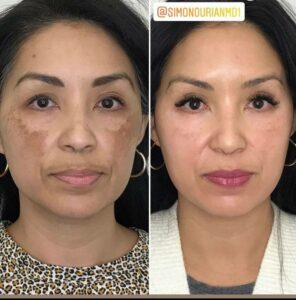Melasma is a common misunderstood skin condition that poses challenges for those who experience it. By shedding light on its causes, unraveling the range of symptoms, and exploring melasma treatment options, our aim is to provide a comprehensive guide that helps individuals gain a better understanding and manage this intricate condition.
What exactly is Melasma?
Melasma is a skin condition characterized by the appearance of gray-brown patches on the skin typically found on the face. These patches frequently manifest on areas such as the cheeks, forehead, nose, chin, and above the lip. Melasma falls under hyperpigmentation, a phenomenon where certain areas of the skin become darker due to a production of melanin. Melanin is the pigment for determining skin color as well as hair and eye color.
When does Melasma occur?
Melasma can arise at points in an individual’s life with no fixed onset pattern. However, it tends to become more prominent in situations such as:
- 1. Pregnancy: Often referred to as “pregnancy mask, ” melasma commonly manifests during pregnancy. Melasma is often caused by changes in hormone levels of estrogen and progesterone; some women may notice melasma developing or worsening when using birth control methods like birth control pills.
- 2. Sun exposure: Also plays a role in the development of melasma after extended periods of time in the sun.
- 3. Genetic predisposition: Additionally, melasma can become more prominent as individuals age without triggers. It tends to be more common in adults between the ages of 20 and 50.
It is important to remember that while these triggers are commonly associated with melasma, not everyone who experiences them will develop the condition. Furthermore, addressing these triggers may lead to fading or improvement of melasma. It can be a recurring issue if proper sun protection measures are not consistently followed. Consulting with a dermatologist is recommended to determine the causes of melasma and develop a treatment plan.
What are the symptoms of Melasma?
The primary indication of melasma is the appearance of gray-brown patches. Melasma patches that usually appear on areas like the cheeks, forehead, nose, chin and above the lip. Some common signs and characteristics of melasma are:
- 1. Patches that have shapes.
- 2. Darkening of the skin.
- 3. Increased pigmentation when exposed to sunlight.
- 4. During pregnancy or hormonal changes.
While melasma is primarily a concern and does not cause discomfort or health issues its presence can greatly impact a person’s self confidence and overall quality of life.
You may schedule an appointment with us today if you suspect you have melasma or notice any changes in your skin for proper diagnosis and appropriate treatment options.
What are the treatments for Melasma?
- 1. Use of skin lightening agents: These may include hydroquinone, retinoids and other lightening agents aimed at reducing pigmentation.
- 2. Sun protection: Regularly applying spectrum sunscreen and wearing clothing can help minimize sun exposure.
- 3. Consideration of chemical peels: These exfoliating treatments can aid in removing the layer of skin.
- 4. Laser therapy: Laser treatments can target areas with pigmentation and stimulate the production of collagen which can be beneficial in managing melasma.
- 5. Medications: In some cases of melasma, dermatologists might prescribe oral medications as part of the treatment plan.
It is important to consult a dermatologist for a treatment plan to address your case of melasma.
Can these treatments cure or eliminate Melasma?
It is important to note that complete eradication may be challenging. However, with treatments and careful management, it is often possible to improve the appearance of melasma and reduce its effects significantly. Many individuals experience a reduction in the visibility of melasma patches, some even achieve a more even skin tone. It is crucial to understand that without management, there is a chance for melasma to recur. Therefore, taking measures such as sun protection plays a role in preventing its return.
In conclusion, understanding its causes, recognizing its symptoms accurately, and exploring treatment options available is important because, with this knowledge and resources, you can effectively navigate your journey with Melasma. Just keep in mind that dealing with melasma can be tough, but with the help of a dermatologist, you can effectively manage it. Embrace the process of improving your skin’s health and radiance and let your natural beauty shine through at Epione.
